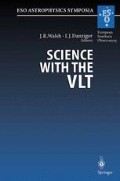Abstract
The VLT Interferometer is capable of doing astrometry with ~ 10 mi-croarcsecond precision over fields of a few arcseconds by measuring the differential delay between the target star and a (possibly faint) reference object in the K band. With this precision, it is possible to detect planets through the reflex motion of the central star at considerable distance; Jupiter could be found out to ~ 1 kpc. The masses of any planets detected can be determined, independently of the inclination of the orbit. In a “key program”, which would use about 300 observing nights over 10 years on VISA (1.8 m telescopes only), 200 stars could be observed, with 20 to 30 measurements for each star. As a result of this program, an inventory of giant planets around stars of various spectral types could be obtained, including the multiplicity and mass function of the planets. Smaller planets (down to ~ 10 Earth masses) could be found around a few nearby stars. Inclusion of pre-main-sequence objects in the target list would give additional information about the formation of planetary systems.
Access this chapter
Tax calculation will be finalised at checkout
Purchases are for personal use only
Preview
Unable to display preview. Download preview PDF.
References
Angel, J.R.P. (1994), Nature 368, 203
Cochran, W.D., Hatzes, A.P. (1994), ApSS 212, 281
Colavita, M.M. (1994), A&A 283, 1027
Dekany, R., Angel, R., Hege, K., Wittman, D. (1994), ApSS 212, 299
ESO VLT Interferometry Panel (1989), The VLT Interferometer Implementation Plan, VLT Report No. 59b
Hummel, CA., Mozurkewich, D., Elias, N.M., Quirrenbach, A., Buscher, D.F., Armstrong, J.T., Johnston, K.J., Simon, R.S., Hutter, D.J. (1994), AJ 108, 326
Lestrade, J.F., Jones, D.L., Preston, R.A., Phillips, R.B. (1994), ApSS 212, 251
Lindegren, L. (1980), A&A 89, 41
von der Luhe, O., Quirrenbach, A., Koehler, B. (1994), these proceedings
Quirrenbach, A., Mozurkewich, D., Buscher, D.F., Hummel, C.A., Armstrong, J.T. (1994), A&A 286, 1019
Shao, M., Colavita, M.M. (1992), A&A 262, 353
Author information
Authors and Affiliations
Editor information
Editors and Affiliations
Rights and permissions
Copyright information
© 1995 Springer-Verlag Berlin Heidelberg
About this paper
Cite this paper
Quirrenbach, A. (1995). Astrometric Detection and Investigation of Planetary Systems with the VLT Interferometer. In: Walsh, J.R., Danziger, I.J. (eds) Science with the VLT. ESO Astrophysics Symposia. Springer, Berlin, Heidelberg. https://doi.org/10.1007/978-3-540-49215-3_4
Download citation
DOI: https://doi.org/10.1007/978-3-540-49215-3_4
Publisher Name: Springer, Berlin, Heidelberg
Print ISBN: 978-3-662-22397-0
Online ISBN: 978-3-540-49215-3
eBook Packages: Springer Book Archive

